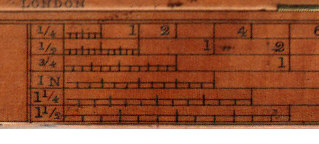2. The company web site gives some information on the history of the company. In the early 19th century Ann Buck married John Roe Hickman. At that time three brothers, George, Joseph and Matthew Buck, were recorded as London toolmakers and dealers. In 1840 Ann Hickman opened a small tool shop, Buck & Co, East End of London. The business flourished with John Roe Hickman and in 1859 Buck & Hickman moved to Whitechapel Road, London. According to the 1841 census, the earliest available on-line, Anne and John Hickman were both 30 years of age and living in Church Lane. They were also there in 1851. John Hickman's occupation was given as toolmaker. The census information is consistent with company web site and would suggest that rule was sold sometime after 1840.
3. In many ways the rule is a fairly standard 19th century 2-fold timber rule. It has the "girt line" for calculating volumes on timber, running from 0.4 to 40. The back of the rule has a scale of inches and the slide also had a scale of inches enabling lengths up to 3 feet to be measured. On the edges of the rule are scales of 100th of a foot, easier for decimal calculation.
4. There is one anomaly. Next to the words "Girt line" are the letters WG and AG. This originally stood for Wine Gallons and Ale Gallon and gauge points for these at 17.15 and 18.95, often marked by a brass pin, are found on many early 19th century slide rules. However these marks became obsolete after the introduction of the Imperial Gallon in 1824. The evidence above suggests that the rule was made, or at last sold, several decades after this date. Whilst the letters WG and AG on this rule are in the correct part of the rule there are no actual marks for the gauge points. My guess is that is that this a copy of an earlier rule which preserved the important information for carpenters but not the gauging information.
5. On the back of the rule are two scales marked E and M. A common task for carpenters when building ships was to cut a square timber to an octagon as a prelude to making a mast. The ratio of the side of the timber to distance from the edge to the cut is 2+Ö2, = 3.414 (E scale) and the ratio of the side of the timber to distance from the middle is 2 (1+Ö2), = 4.828. The ratios on the rule not quite correct, 34.25 and 48.0, respectively. For more information on timber rules see here.
6. The rule also has proportioning scales which enable diagrams to be scaled up or scaled down or taken from architects drawings.
Front view

Back view

Maker's name
![]()
Detail -proportioning scales

Detail - gauge points

E and M scales
